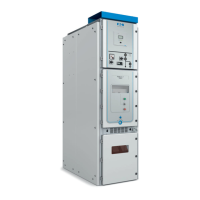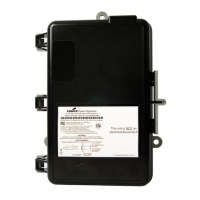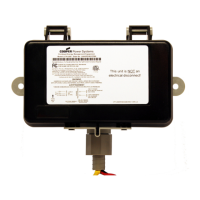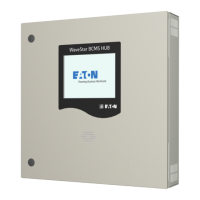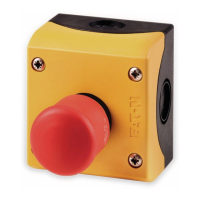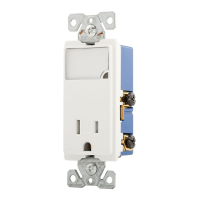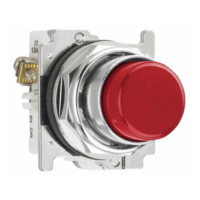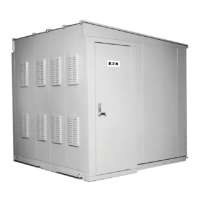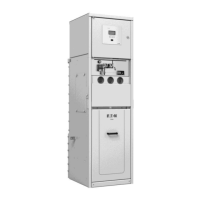I.L. PG24836G-591H
Page 6 Página 6
Effective: November 1999 Efectivo: Noviembre 1999
Do not make any connections other than those shown on the
nameplate or diagram. Do not change connections or taps while the
unit is energized.
This dry-type transformer was built and tested in accordance with
applicable standards of American National Standards Institute and
National Electrical Manufacturers’s Association.
The following operations guides are excerpts from these standards.
WARNING
IT IS IMPORTANT TO FOLLOW THE GUIDELINES SET FORTH
BELOW. FAILURE TO DO SO COULD RESULT IN SEVERE
PERSONAL INJURY, DEATH, PROPERTY DAMAGE, OR REDUCED
TRANSFORMER LIFE.
The maximum allowed overvoltage is 5% above rated secondary
voltage at rated kVA load with load power factor at least 80%. If the
transformer is energized while the secondary is not connected to a
load, then the voltage applied to the primary must not result in a
voltage exceeding 110% of the rated secondary voltage.
Continuous overload capability is not deliberately designed into
general purpose transformers. For short term overload capability,
See ANSI C57.96-01.250 for guidelines and limitations.
Transformers depend entirely on the surrounding air for adequate
ventilation. The ambient should not exceed 40ºC (104ºF) and the
average temperature of the air for any 24 hour period should not
exceed 30ºC (86ºF). For operation at higher ambients, transformer
loading should be reduced 0.6% of rated KVA for each degree above
30ºC average ambient to a maximum of 50ºC (122ºF).
The transformer may be connected in parallel with other transformers
if the phase angle shift is the same; phase rotation is the same;
transformers’ turn ratios and voltage ratings are within a 0.5% range;
and the percent impedance on the same kVA base is within a ±7.5%
range.
Transformers are normally designed for operation at altitudes below
1000 meters (3300 feet). To operate a transformer above 1000 meters,
it is necessary to reduce the kVA load and to increase the electrical
insulation clearances between energized terminals. Refer to NEMA
ST-20 for detailed guidelines.
9. MAINTENANCE AND REPAIR
WARNING
BEFORE ATTEMPTING REPAIRS, FOLLOW THE INSTRUCTIONS
SET FORTH BELOW. DE-ENERGIZE THE TRANSFORMER
BEFORE MAKING REPAIRS. FAILURE TO DO SO COULD RESULT
IN SEVERE PERSONAL INJURY, DEATH, OR PROPERTY DAMAGE.
It is the responsibility of the owner to inspect, maintain and keep the
transformer in good repair.
Report all failures during the warranty period to your local sales office
prior to repairs. All warranty repairs must be made or approved by the
manufacturer.
No intente realizar conexiones no mostradas en la placa de datos. No
intente modificaciones o cambio de derivaciones (taps) con el
transformador energizado.
Este transformador tipo seco fué construído y probado de acuerdo a
normas aplicables A.N.S.I. (American National Standards Institute, E.U.A.)
Las siguientes instrucciones de operación son extractos de esas
normas.
ADVERTENCIA
ES IMPORTANTE SEGUIR LAS RECOMENDACIONES QUE SE
MENCIONAN. EL NO ACATARLAS PUEDE RESULTAR EN LESIONES
PERSONALES SEVERAS, MUERTE, DAÑO EN PROPIEDAD O
REDUCCIÓN DE LA VIDA ÚTIL DEL TRANSFORMADOR.
El máximo sobrevoltaje permitido es 5% sobre el voltaje nominal
secundario, a carga (kVA) nominal, con un factor de potencia de al
menos 80%. Si el transformador se energiza sin que el secundario
esté conectado a una carga, entonces el voltaje aplicado al primario
no debe provocar un voltaje secundario mayor al 110% del nominal.
Los transformadores de uso general no están intencionalmente
diseñados para soportar sobrecargas contínuas. Para información y
orientación sobre la operación de sobrecarga en periodos cortos de
tiempo, consulte A.N.S.I. C57.96-01.250.
Los transformadores ventilados dependen completamente del aire
circundante para su adecuada ventilación. El ambiente no debe
exceder los 40ºC (104ºF) y el promedio de temperatura del aire, en un
periodo de 24 horas, no debe exceder los 30ºC (86ºF). Para operación
a mayores temperaturas, la carga del transformador se reduce un
0.6% de la potencia nominal en KVA por cada grado sobre 30ºC
(86ºF) de ambiente promedio, hasta un máximo de 50ºC (122ºF).
El transformador puede conectarse en paralelo con otros
transformadores si: el ángulo de fase es el mismo, la rotación de fase
es igual, la relación de vueltas y los voltajes nominales están dentro
de un 0.5% del rango, y el porcentaje de impedancia, basado en
mismos KVA, está dentro del rango de ± 7.5%.
Los transformadores normalmente se diseñan para operar a altitudes
por debajo de 1000 metros ( 3300 Ft. ). Operando sobre 1000m es
necesario reducir la carga en KVA e incrementar los claros entre
terminales energizadas. Consulte N.E.M.A. ST-20 para más detalles.
9. MANTENIMIENTO Y REPARACION
ADVERTENCIA
ANTES DE INTENTAR DAR SERVICIO, SIGA LAS INSTRUCCIONES
QUE SE DARÁN. DESENERGICE ESTE EQUIPO ANTES DE
TRABAJAR EN ÉL. EL NO HACERLO PUEDE CAUSAR LESIONES
PERSONALES SEVERAS, MUERTE O DAÑOS EN PROPIEDAD.
Es responsabilidad del propietario la inspección, mantenimiento y
reparación del transformador.
Durante la vigencia de la garantía notifique toda falla a su oficina de
ventas antes de reparar. Toda reparación bajo garantía debe ser hecha
o aprobada por el fabricante.

